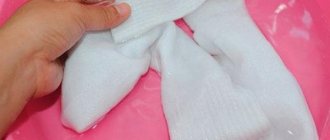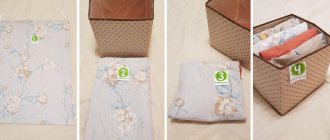Why starch things
When ironing linen treated with a special substance, a thin, transparent and even film is formed on the surface of the textile. It performs protective, strengthening and decorative functions:
- the structure of the material becomes denser and holds its shape, creasing is prevented;
- most of the contaminants that get on the fabric will be washed off along with the strengthening agent, and will not be ingrained into the threads;
- an environmentally friendly barrier is created that does not irritate the skin, but as soon as water gets on the starched area, it disappears.
Important: there are products with a whitening effect. When purchasing, make sure there is a corresponding mark.
This procedure is performed on bed linen, bathrobes, and shirts. But not everything can be processed.
Why do you starch laundry?
Processing of things is used to impart rigidity to the material. The polysaccharides contained in starch, after drying, form a thin but strong, elastic film on the surface.
Pros of starching:
- imparts rigidity: things retain their given shape longer and wrinkle less;
- protects against stains: the starch film prevents dirt from penetrating into the fibers, so the laundry is easier to wash;
- enhances the whiteness of the fabric: starched items visually appear lighter and cleaner;
- gives clothes fullness: petticoats and skirts become stiffer and hold their shape better;
- extends the life of linen.
As for the shortcomings, there are few of them. The main disadvantage is the reduction in the breathability of the material. Therefore, it is not recommended to starch underwear and summer clothes (only individual parts). Hard fabric will irritate the skin and interfere with normal ventilation.
What things is it suitable for?
The product used for starching plays an important role in this matter. You should be careful with industrial compounds and first study the instructions. Some manufacturers do not recommend use on synthetics.
The procedure is suitable for tablecloths, tulle, curtains, napkins and shirts that have cuffs and collars. Don't forget about bed linen. After all, this is a separate kind of pleasure - sleeping on a boiling white bed, “crispy” from cleanliness. A wedding dress is often treated in this way at home, making the bride’s outfit even more perfect.
Use is allowed not only on white, but also on colored fabrics made from natural materials or synthetics. You just need to remember about the individual approach. The amount of product is selected depending on the hardness of the water, the type of material and the processing method.
What you can't starch
To avoid unforeseen situations and not spoil the item, it is enough to know some of the nuances associated with the procedure.
The following things should not be starched:
- Underwear. Due to the fact that the resulting film does not allow air to pass through well, it is unhygienic to cover clothing with it in close contact with the body. This will have a negative impact on the fabric and skin. Redness, irritation and itching may occur. Especially in the summer.
- Dark things. White stains will remain that will have to be washed off, which makes the procedure pointless.
This is interesting: it is not forbidden to starch synthetics. But if the combined material acquires the desired properties, then completely artificial fibers will react poorly to the influence of the strengthening agent.
How to make your own mixture
It is well known that fabric differs in structure, thickness and other properties. Based on this, clothes need to be starched in different ways, taking into account the characteristics of the selected textile.
Processing options: table
| View | What is it suitable for? | Recipe |
| Soft | Bed linen, curtains and thin fabrics (cambric, tulle, chiffon). | Dilute 1 tsp in 1 liter of water. starch. Stir until the lumps disappear. |
| Average | Shirts, tablecloths, lace items, bows, napkins, robes. | The amount of substance for the same volume of liquid is greater - 1 tbsp. |
| Hard | Collars, cuffs and other parts that need a stable shape. It is not recommended to completely cover the item with such a thick film. | For 1 liter of water you will need 2 tbsp. starch. Dissolve until smooth. Dilute 1 tsp in a small amount of hot liquid. and add to the solution. Mix thoroughly until a homogeneous consistency is obtained. Let it brew for 2 hours. |
Tip: you can use not only potato starch, but also corn, rice or wheat starch. The product obtained from tubers is especially popular because it thickens well.
Classic dress starching
Professional starching products are available to the consumer. Potato starch makes the fabric stiff, gives it a beautiful shape and successfully competes with them. Along with potato products, rice and corn products are widely used. You can use the one you had on hand. To give mixed fabric items the desired shape and improve their appearance, it is recommended to use rice starch.
Proportions of solutions: table by fabric type
During starching, you can adjust its hardness. This directly depends on the amount of starch, the material from which the product is made. Starching comes in different hardnesses.
| Rigidity | Starch per 1000 ml of water | What things is it suitable for? |
| Soft | 0.5-1 tsp. | Chiffonovs |
| Knitted | ||
| Mardevykhs | ||
| Batistov | ||
| Sitzevs | ||
| Muslinovs | ||
| Tulle | ||
| Average | 1 tbsp. l. | Silk |
| Fatinovs | ||
| Cotton | ||
| Linen | ||
| Made from mixed fabrics | ||
| From staple | ||
| For bed linen | ||
| For table linen - tablecloths, napkins | ||
| For furniture covers, elegant capes | ||
| For openwork products | ||
| Tough | 2 tbsp. l. | Petticoats in layered outfits |
| Cuffs | ||
| Vorotnikov | ||
| Knitted items |
You can independently change the level of hardness of the solution, but it is worth remembering that not every fabric can withstand such exposure.
Processing things
Before you start processing things, you should watch a thematic video and photo. This applies to those who decided to undergo such a procedure for the first time. The available methods explain the steps step by step.
First of all, the composition for starching is prepared.
- Pour dry starch into the bottom of the container (pan).
- Add liquid - half the required amount.
- Mix until creamy.
- Add the second part of water in the form of boiling water.
- Mix everything. The composition should resemble a paste.
- If the mixture becomes cloudy, put it on the fire and boil for 5 minutes, stirring so that lumps do not form. If there are any, the mixture must be strained using cheesecloth.
The finished solution must be cooled. Wash the dress thoroughly beforehand, making sure there are no stains. Immerse items at room temperature. Next, you need to carry out the following manipulations:
- Place the clothes in the prepared and cooled composition. Make sure it evenly covers the dress. If necessary, all small parts must be straightened.
- Wait for the starch to be absorbed into the fabric. Take the item out and inspect it for dry areas. If necessary, lower back into the mixture for a few minutes.
- Carefully remove excess liquid, preventing wrinkles from forming. It will be almost impossible to iron them.
You need to keep the product in the solution from half an hour to 40 minutes. This is enough for the fabric to starch well and achieve the desired stiffness.
Drying rules
Drying things after starching is a separate process that needs to be approached correctly. If you hang the fabric incorrectly, it will take the same position and you won’t be able to smooth it out in the future. To prevent this, you should remember the basic rules.
- The dress should dry exclusively on hangers. It is necessary to carefully smooth out wrinkles, which can literally “petrify” if you do not get rid of them in time.
- Drying is not carried out at high or low temperatures.
- Additional heat sources cannot be used for drying.
Note!
If possible, it is better to place the item on a mannequin. This will allow it to take the desired shape.
Drying knitted items requires a special approach. The process takes place on a soft surface that perfectly absorbs moisture. The lace product must first be straightened using needles to give the desired shape.
Ironing nuances
It is important to iron starched clothes properly. If ironing occurs when the fabric has lost moisture, individual areas should be sprinkled with water and a number of other nuances should be taken into account:
- set the iron to medium power;
- disable the steam function;
- iron the dress through gauze.
Some materials strongly stick to the iron fabric during ironing. Adding 4 drops of turpentine and a teaspoon of salt to the solution will get rid of the problem. You can iron knitted items only from the reverse side by turning on the steam mode.
Professional products: sprays, liquids and powders
In addition to the well-known grandmother’s method, there is a more modern, simpler and less energy-consuming method. Among household chemicals, starch products have long appeared. A wide range allows you to choose the most convenient option.
Advantages:
- They are available in the form of an ironing spray, liquid or powder, which allows you to choose the form of the product that is convenient for you and which will be easier to work with.
- Convenient and easy to use.
- Starch spray is applied to individual parts of clothing, which greatly facilitates the process. It is enough to use it while ironing.
- For processing large canvases, a bulk product is better suited. It is simply added to the machine during washing.
Important: regardless of the type of drug, before using it, you must study the instructions and follow safety precautions. Ironing spray that gets on your skin can cause irritation.
The best products for starching laundry
- Luxus Professional Superform - spray is sprayed onto clothes during ironing. Comfortable and easily contacts the iron coating. It evens out dry and wrinkled laundry. Ideal for emergency creation of a flawless image. German product, costs about 350-400 rubles. The composition contains a highly purified natural product.
- "Domol" from Germany - starch for ironing in aerosols. Suitable for people with sensitive skin. It makes ironing effortless. Cannot be used on dark things - light stains will remain. Price - from 480 to 550 rubles.
- Cotico is a liquid product for starching laundry of any material. Can be used for hand or machine wash. It is produced in the Russian Federation and costs approximately 270-700 rubles, depending on the packaging capacity. It prevents the product from becoming too wrinkled even during wet cleaning and provides a pleasant aroma of freshness.
Sprays for starching things are more popular than other professional products due to their local application. Nowadays, few people process bed linen, curtains or tablecloths. Increasingly, this procedure concerns only elements of clothing that should have a representative appearance.
Alternative Methods
Among the folk methods of starching, there are recipes that use other substances. They are available in every home and give almost the same effect.
Sugar
This starch agent is used primarily on napkins or lace. Not recommended for use on everyday clothing.
Cooking method:
- Heat 100 ml of water in a small saucepan until warm.
- Dilute 200 g of sugar in it.
- Continue heating over low heat, stirring constantly.
- As soon as the solution begins to boil, remove the container from the stove and allow to cool.
The disadvantages of this substance include its rapid dissolution and the appearance of a sticky coating after getting wet. Outdoors, the “candied” fabric attracts insects.
Important: overcooked syrup acquires a yellow tint, which can negatively affect the color of the material.
Milk
It is used primarily for fixing the shape of openwork napkins.
Cooking method:
- Mix 200 ml of milk and 0.5 tbsp. rice starch.
- Boil another 300 ml of milk and pour in the mixture obtained earlier.
- Let cool.
- Immerse the product in the solution for 20 minutes. Remove, squeeze by hand and lay out to dry.
Gelatin
Great for processing knitted, silk and dark items. Does not leave light streaks. It is better not to use this product for starching laundry. A large amount of the basic substance will be needed, and during sleep the bed may begin to stick, heated by human heat.
Cooking method:
- Add 1 tbsp. granular substance in 1/2 cup of water. Leave to swell. While waiting, stir several times with a spoon.
- Fill the container to the brim with water, wait until the grains swell and become soft.
- Transfer the resulting mixture to a small saucepan and heat over low heat until the gelatin is completely dissolved. Don't let it boil. Apply when it has cooled down a bit.
This product does not have a bleaching effect, so the item being treated must already be cleaned and bleached, if necessary.
PVA glue
To starch woolen items, knitted flowers, openwork and knitwear, you can use glue diluted with water in a ratio of 1:2. Before applying, you should place a film or thick paper under the item.
For silk and organza use silicate glue: dilute 1 tsp. for 5 liters of water. For 200 ml of liquid, 1 drop of the main substance is enough.
Starching a wedding dress yourself
The procedure will be effective if you follow simple rules:
- Before starting the procedure, it is important to thoroughly wash the outfit, removing all stains and dirt from it;
- prepare a solution - 1 tbsp. l. starch per 1 liter of clean water;
- lower the product into the warm composition;
- if the lower part is lush, it can be treated with a spray bottle;
- after swimming, wring out the dress and hang it to dry naturally;
- When the outfit is dry, be sure to iron it.
It is not recommended to speed up the drying process. If starching does not give the desired result the first time, you can repeat the procedure by making a more concentrated solution. Ironing should be done without using steam. You can place a damp cloth under the iron.
Rules for starching laundry at home
Depending on the thing that needs to be processed, the method is chosen. To shape cuffs, a collar or a petticoat, the dry method is sufficient. Starching a small wardrobe item or delicate item is done by hand, but curtains and bed linen can easily survive the procedure with a washing machine.
Dry
- To use the purchased starch spray, no special manipulations are required. It is enough to apply it to the fabric during ironing.
- The second method forces you to place paper under the item. Using an iron or spray bottle, spray the laid out clothes with water and then sprinkle with a thin layer of dry potato starch. Place another sheet on top and smooth it out. After the procedure, remove barriers and shake off any remaining powder.
Manually
- Wash the item as usual.
- Immerse the product completely or partially in the solution prepared in advance for 15-30 minutes.
- Take out the clothes and squeeze lightly to remove excess liquid.
- Dry at room temperature. If this is clothing, then it must be on hangers, in a suspended state.
In the washing machine
For washing in the unit, as a rule, they use a special powder or a liquid analogue, and not a homemade paste. An industrial preparation will evenly cover the entire thing, but a homemade solution will not give the same result.
When performing the procedure for the first time, it is better to experiment with a small piece of tissue. Usually folk or professional remedies are tested on handkerchiefs. In the future, you need to perform processing in the correct sequence and no difficulties will arise, and the effect will be as in the photo.
How to properly starch fabric
There are several basic rules for starching fabric. This will be discussed in more detail below.
Rules and procedure for starching
If you don’t know how to starch fabric well at home, follow these instructions:
- Place clean items in a container with starch solution. Spread them out.
- Leave them in this position for a quarter of an hour.
- Squeeze, shape, and wait until completely dry.
To enhance the brightness of snow-white fabrics, add 1 drop of blue to the starch solution. To make ironing the item easier, you can pour about 2 tsp into the solution. fresh milk.
How to starch things in the washing machine
Sometimes you can starch things in the washing machine. You must first disable the “Rinse” function for the process to be successful. Prepare a soft starch solution and pour it into the compartment intended for the conditioner. Wash as usual.
Afterwards, remove the clothes from the washing machine, shake them, and hang them up. This will prevent wrinkles from forming. After washing, wipe the drum with a cloth to remove any remaining starch.
How to dry starched items
When the item is treated with starch solution, it must be dried properly. This should be done in a well-ventilated room. If this is not possible, it should have a good ventilation system. Place laundry away from heating devices. Also, you should not do this on the street or on the balcony. This can have a negative impact on tissues. Make sure that the materials are not exposed to direct sunlight.
It is better to hang outerwear and bedding in a vertical position. This way they will acquire the necessary correct shape. To avoid creases, do not wring the fabric too hard. To starch napkins and lace products, they should be laid out on a terry towel in a horizontal position. They must first be carefully leveled and securely secured with pins.
Using starch solutions, you can make fabrics more rigid and elastic. The advantages of starching include environmental friendliness. The structure of the fabrics will not be destroyed by chemicals.











